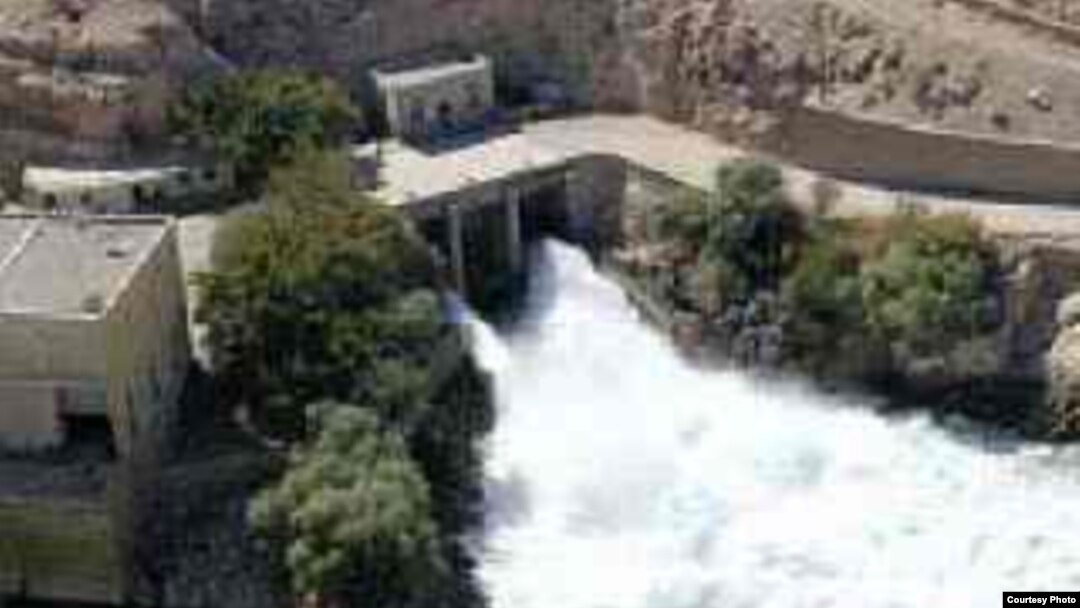Kajaki Dam, which lies near the source of the Helmand River (USAID photo) (Courtesy Photo)
January 12, 2007 (RFE/RL) -- NATO forces in Afghanistan say the destruction of a Taliban camp in Helmand Province has cleared the way for repairs on a major hydroelectric dam. Work was halted in 2006 due to resurgent Taliban violence, but engineers from USAID now hope to upgrade the Kajaki Dam and its electrical transmission lines to provide a reliable source of power for nearly 2 million people in southern Afghanistan.
The British military operation targeting Taliban fighters in the northern part of Helmand Province began on January 1.
After about a week, NATO officials announced that they had killed a local commander of insurgents who have been stalling a multimillion-dollar repair project on Kajaki Dam's electricity-producing turbines, which lies near the source of the Helmand River.
Worker Safety
NATO-ISAF spokesman Dominic Whyte tells RFE/RL the alliance is confident that it can keep the area safe for construction workers and engineers who must live in a campsite near the dam.
"The Kajaki Dam is a critical part of the infrastructure necessary for the redevelopment of Afghanistan," Whyte says. "ISAF forces operating in the area are patrolling to ensure the security of the wider area itself so that the necessary reconstruction work can take place. We do have troop locations -- forward operating bases. We also employ mobile patrols."
James Franckiewicz, director of USAID's Office of Infrastructure, Engineering, and Energy in Afghanistan, tells RFE/RL that Taliban fighters managed to stop all work at the dam site for more than half a year.
"We've been on hold for about six or seven months right now," Franckiewicz says. "We had a subcontractor that was due to go into Kajaki at the site to start working in May [2006]; they were unable to get access. In fact, they demobilized everyone aside from the security people back in the summer of 2006."
Franckiewicz explains that the halt of reconstruction work was a direct result of resurgent Taliban violence in Helmand Province.
"The insurgency around the camp spiked last summer [2006] and got much worse," Franckiewicz says. "A lot of the workers deserted out of the site after the increased violence. They started receiving mortar rounds fairly regularly. And one of the conditions that USAID had put out is that the coalition had to stabilize the area -- a perimeter about three to five kilometers around our campsite -- in order to stop the incoming mortar rounds. The military has been focusing on this area for a while and those mortar rounds pretty much died away during the last couple of months."
There are three key parts to USAID's reconstruction project at Kajaki that Franckiewicz hopes will be completed by the summer of 2009 -- the upgrade of electricity-generating equipment, the installation of new power-transmission lines, and the construction of a road linking the Kajaki Dam site to Afghanistan's main ring road.
He says he expects workers back at the dam in February to start repairing damage to one of Kajaki's existing two turbines. The workers also plan to install a new, third turbine -- which already is being shipped to Afghanistan.
Obstacles To Delivery
When work on the turbines is finished, Kajaki's electricity-generating capacity will be more than double its current level. But servicing the infrastructure, and carrying all of that electricity to the nearby cities of Lashkar-Gah and Kandahar, is impossible on roads and transmission lines destroyed by decades of war.
"The existing transmission line is in poor shape -- and we're going to be rehabilitating the transmission line," Franckiewicz says. "There is about 190 kilometers of transmission line that we are going to build down there. And we're going to build about 90 kilometers of access road from the main regional ring road up to Kajaki Dam site. The upgrade of the hydro-electric plant and the transmission line will give a reliable electricity supply for both Lashkar-Gah and Kandahar and a few villages that will be services along the transmission line."
Franckiewicz says building the new transmission line will take longer than upgrading the dam's hydroelectric stations.
"We're assuming as long as the security situation stabilizing and that we get cooperation from the coalition forces, we're going to have the contractors mobilized in February and we're going to finish the hydroelectric in 2007 -- by the end of this year," Franckiewicz says. "I would guess [it will be] around the summer of 2009 before the transmission line and road construction is completed."
200,000 Households Await
If all goes according to plan, the project will affect the lives of hundreds of thousands of people in Afghanistan's volatile southern provinces of Helmand and Kandahar.
"What we have as total beneficiaries in this area that will benefit from the Kajaki upgrade is 1.7 million inhabitants," Franckiewicz says. "And we figure, just on the basis of approximately eight people per household, that there [are] about 200,000 households. I would assume you're probably looking at somewhere from 30 to 50 percent of the people with their lightbulb power on in their residence. That's what is available now. And what we're looking at as possible, when we get this thing up and running, we assume that all of the households, businesses, and government are going to be able to have power for their basic needs."
NATO-ISAF spokesman Whyte admits that it will be more difficult for NATO forces to protect the power transmission lines from Taliban attacks than it is to project the dam site itself.
But Whyte says he hopes the benefits of an improved Kajaki Dam convince ordinary Afghans that it is in their best interest to cooperate with Afghan and NATO security forces who protect the system.
After about a week, NATO officials announced that they had killed a local commander of insurgents who have been stalling a multimillion-dollar repair project on Kajaki Dam's electricity-producing turbines, which lies near the source of the Helmand River.
Worker Safety
NATO-ISAF spokesman Dominic Whyte tells RFE/RL the alliance is confident that it can keep the area safe for construction workers and engineers who must live in a campsite near the dam.
"The Kajaki Dam is a critical part of the infrastructure necessary for the redevelopment of Afghanistan," Whyte says. "ISAF forces operating in the area are patrolling to ensure the security of the wider area itself so that the necessary reconstruction work can take place. We do have troop locations -- forward operating bases. We also employ mobile patrols."
James Franckiewicz, director of USAID's Office of Infrastructure, Engineering, and Energy in Afghanistan, tells RFE/RL that Taliban fighters managed to stop all work at the dam site for more than half a year.
"We've been on hold for about six or seven months right now," Franckiewicz says. "We had a subcontractor that was due to go into Kajaki at the site to start working in May [2006]; they were unable to get access. In fact, they demobilized everyone aside from the security people back in the summer of 2006."
Franckiewicz explains that the halt of reconstruction work was a direct result of resurgent Taliban violence in Helmand Province.
"The insurgency around the camp spiked last summer [2006] and got much worse," Franckiewicz says. "A lot of the workers deserted out of the site after the increased violence. They started receiving mortar rounds fairly regularly. And one of the conditions that USAID had put out is that the coalition had to stabilize the area -- a perimeter about three to five kilometers around our campsite -- in order to stop the incoming mortar rounds. The military has been focusing on this area for a while and those mortar rounds pretty much died away during the last couple of months."
There are three key parts to USAID's reconstruction project at Kajaki that Franckiewicz hopes will be completed by the summer of 2009 -- the upgrade of electricity-generating equipment, the installation of new power-transmission lines, and the construction of a road linking the Kajaki Dam site to Afghanistan's main ring road.
He says he expects workers back at the dam in February to start repairing damage to one of Kajaki's existing two turbines. The workers also plan to install a new, third turbine -- which already is being shipped to Afghanistan.
Obstacles To Delivery
When work on the turbines is finished, Kajaki's electricity-generating capacity will be more than double its current level. But servicing the infrastructure, and carrying all of that electricity to the nearby cities of Lashkar-Gah and Kandahar, is impossible on roads and transmission lines destroyed by decades of war.
"The existing transmission line is in poor shape -- and we're going to be rehabilitating the transmission line," Franckiewicz says. "There is about 190 kilometers of transmission line that we are going to build down there. And we're going to build about 90 kilometers of access road from the main regional ring road up to Kajaki Dam site. The upgrade of the hydro-electric plant and the transmission line will give a reliable electricity supply for both Lashkar-Gah and Kandahar and a few villages that will be services along the transmission line."
Franckiewicz says building the new transmission line will take longer than upgrading the dam's hydroelectric stations.
"We're assuming as long as the security situation stabilizing and that we get cooperation from the coalition forces, we're going to have the contractors mobilized in February and we're going to finish the hydroelectric in 2007 -- by the end of this year," Franckiewicz says. "I would guess [it will be] around the summer of 2009 before the transmission line and road construction is completed."
200,000 Households Await
If all goes according to plan, the project will affect the lives of hundreds of thousands of people in Afghanistan's volatile southern provinces of Helmand and Kandahar.
"What we have as total beneficiaries in this area that will benefit from the Kajaki upgrade is 1.7 million inhabitants," Franckiewicz says. "And we figure, just on the basis of approximately eight people per household, that there [are] about 200,000 households. I would assume you're probably looking at somewhere from 30 to 50 percent of the people with their lightbulb power on in their residence. That's what is available now. And what we're looking at as possible, when we get this thing up and running, we assume that all of the households, businesses, and government are going to be able to have power for their basic needs."
NATO-ISAF spokesman Whyte admits that it will be more difficult for NATO forces to protect the power transmission lines from Taliban attacks than it is to project the dam site itself.
But Whyte says he hopes the benefits of an improved Kajaki Dam convince ordinary Afghans that it is in their best interest to cooperate with Afghan and NATO security forces who protect the system.



